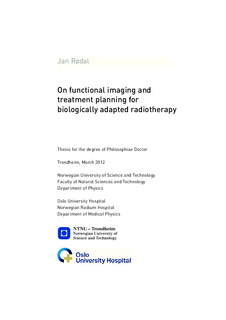| dc.contributor.author | Rødal, Jan | nb_NO |
| dc.date.accessioned | 2014-12-19T13:17:23Z | |
| dc.date.available | 2014-12-19T13:17:23Z | |
| dc.date.created | 2012-03-30 | nb_NO |
| dc.date.issued | 2012 | nb_NO |
| dc.identifier | 513028 | nb_NO |
| dc.identifier.isbn | 978-82-471-3400-9 (printed ver.) | nb_NO |
| dc.identifier.isbn | 978-82-471-3401-6 (electronic ver.) | nb_NO |
| dc.identifier.uri | http://hdl.handle.net/11250/246629 | |
| dc.description.abstract | Tumours show large variations in response to radiotherapy, both across tumour types and within individual tumours. One way to counteract radioresistance is to increase the radiation dose to resistant regions by so-called biologically adapted therapy. Visualisation of these regions based on properties related to radioresistance, such as metabolism, hypoxia, proliferation, and vascularisation, can act as basis for target definition, and can be obtained by PET/CT, dynamic MRI, and dynamic CT imaging.
One aim of the present work was to improve tumour visualisation in images obtained before and during radiotherapy. An analysis of dynamic FDG-PET (D-PET) and dynamic contrast-enhanced CT (DCE-CT) images of three canine patients showed similarities between the two image modalities with respect to tumour vascularisation. The results indicated that D-PET may be used alone for assessment of both tumour perfusion and metabolic activity, simplifying the image acquisition. We also investigated a new method for tumour visualisation by use of image subtraction in CE cone-beam CT (CE-CBCT) images, obtained during IMRT of one of the dogs. The method was shown to be feasible and produced images with a clearly visualised tumour.
We further aimed to investigate the radiobiological effect of biologically adapted dose delivery. An IMRT planning study based on CE-CBCT images of the first canine IMRT patient demonstrated that such dose planning was feasible. This approach gave the highest effect on the tumour and thus showed that biologically adapted treatment was the best choice for this treatment case. Furthermore, a hypoxia dose painting study with a highly heterogeneous tumour model, where MLC leaf widths and IMRT parameters were varied, indicated that reducing the leaf widths from 10 to 5 or 2.5 mm gave increased tumour control probability. We also implemented dose painting by contours in an anthropomorphic phantom. An optimal dose delivery was not achieved.
In conclusion, dynamic FDG-PET before radiotherapy and CE-CBCT during radiotherapy may be valuable. Dose painting should preferably be delivered by MLCs with small leaf widths. However, a high radiobiological effect from high-resolution dose painting could not be demonstrated in practice. An alternative dose painting approach or treatment modality may thus be required for biologically adapted dose delivery to highly heterogeneous tumours. | nb_NO |
| dc.language | eng | nb_NO |
| dc.publisher | Norges teknisk-naturvitenskapelige universitet, Fakultet for naturvitenskap og teknologi, Institutt for fysikk | nb_NO |
| dc.relation.ispartofseries | Doktoravhandlinger ved NTNU, 1503-8181; 2012:65 | nb_NO |
| dc.relation.haspart | Malinen, Eirik; Rodal, Jan; Knudtsen, Ingerid Skjei; Sovik, Aste; Skogmo, Hege Kippenes. Spatiotemporal analysis of tumor uptake patterns in dynamic (18)FDG-PET and dynamic contrast enhanced CT. Acta Oncologica. (ISSN 0284-186X). 50(6): 873-882, 2011. <a href='http://dx.doi.org/10.3109/0284186X.2011.579161'>10.3109/0284186X.2011.579161</a>. | nb_NO |
| dc.relation.haspart | Rødal, Jan; Søvik, Aste; Skogmo, Hege Kippenes; Knudtsen, Ingerid Skjei; Malinen, Eirik. Feasibility of contrast-enhanced cone-beam CT for target localization and treatment monitoring. Radiotherapy and Oncology. (ISSN 0167-8140). 97(3): 521-524, 2010. <a href='http://dx.doi.org/10.1016/j.radonc.2010.07.006'>10.1016/j.radonc.2010.07.006</a>. | nb_NO |
| dc.relation.haspart | Sovik, Aste; Rodal, Jan; Skogmo, Hege K.; Lervag, Christoffer; Eilertsen, Karsten; Malinen, Eirik. Adaptive radiotherapy based on contrast enhanced cone beam CT imaging. Acta Oncologica. (ISSN 0284-186X). 49(7): 972-977, 2010. <a href='http://dx.doi.org/10.3109/0284186X.2010.498433'>10.3109/0284186X.2010.498433</a>. | nb_NO |
| dc.relation.haspart | Rodal, Jan; Sovik, Aste; Malinen, Eirik. Influence of MLC leaf width on biologically adapted IMRT plans. Acta Oncologica. (ISSN 0284-186X). 49(7): 1116-1123, 2010. <a href='http://dx.doi.org/10.3109/0284186X.2010.498832'>10.3109/0284186X.2010.498832</a>. | nb_NO |
| dc.relation.haspart | Rodal, Jan; Waldeland, Einar; Sovik, Aste; Malinen, Eirik. Dosimetric verification of biologically adapted IMRT. Medical physics (Lancaster). (ISSN 0094-2405). 38(5): 2586-2594, 2011. <a href='http://dx.doi.org/10.1118/1.3581406'>10.1118/1.3581406</a>. | nb_NO |
| dc.title | On functional imaging and treatment planning for biologically adapted radiotherapy | nb_NO |
| dc.type | Doctoral thesis | nb_NO |
| dc.contributor.department | Norges teknisk-naturvitenskapelige universitet, Fakultet for naturvitenskap og teknologi, Institutt for fysikk | nb_NO |
| dc.description.degree | PhD i fysikk | nb_NO |
| dc.description.degree | PhD in Physics | en_GB |

